24.Cluster of Springs in Minami-Aso District Geosite
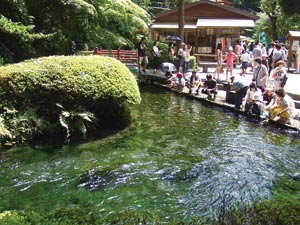
Volcanic springs and daily life
Like many other volcanic regions, Aso is blessed with abundant freshwater springs, some of which bubble from the ground in Nangodani Valley, in the southern section of the caldera. Springs in the Minami-Aso region are distinguished by the complexity of the water systems that feed them, flowing through the caldera topography and central cone group.
Shirakawa Spring, the region's most famous water source, has been selected by the Environment Ministry as one of the country's top 100 aquatic resources. Nearby springs include Shioisha Suigen, Terasaka Suigen, Wakisawazu Suigen, Ikenokawa Suigen, Yoshidajogokenjo Kumiba, Myojin Ike, and Takizaki Suigen. Fed mainly by groundwater from the central cone group as well as water from the southern outer rim, these springs are known for the abundant flow and high water quality.
In December 1973, construction began on a tunnel to link the Takachihocho and Takamori rail lines. In February 1977, however, a sudden flood halted work. Water gushed from the ground at over 36 tons per minute, and similar floods followed regularly. Eventually the tunnel project was cancelled altogether. Today 550 meters of the tunnel is open to the public as the Takamori Spring Tunnel Park, which is also a geosite.
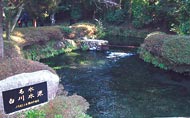
Minamiaso Village Spring Group
This spring group includes Shirakawa Suigen, Shioisha Suigen, Terasaka Suigen, Wakisawazu Suigen, Ikenokawa Suigen, Yoshidajogokenjo Kumiba, Myojin Ike, and Takezaki Suigen. Located primarily on the north side of the Shirakawa River, their source is most likely groundwater from the central cone group.
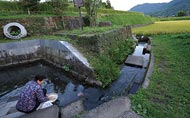 Yoshidajogokenjo Kumiba Yoshidajogokenjo Kumiba |
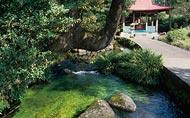 Ikenokawa Suigen Ikenokawa Suigen |
 Terasaka Suigen Terasaka Suigen |
 Takezaki Suigen Takezaki Suigen |
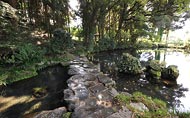 Myojin Ike Suigen Myojin Ike Suigen |
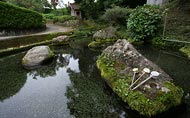 Myoken Shrine Myoken Shrine |
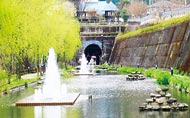
Takamori Spring Tunnel
During construction of a tunnel linking the Takachihocho and Takamoricho rail lines, water began gushing from a spring 2050 m from the mouth of the tunnel. Construction was cancelled and the incomplete tunnel became the Takamori Spring Tunnel. The tunnel is especially cool during summer, and has grown into a popular spot for summer festivals such as Tanabata.
